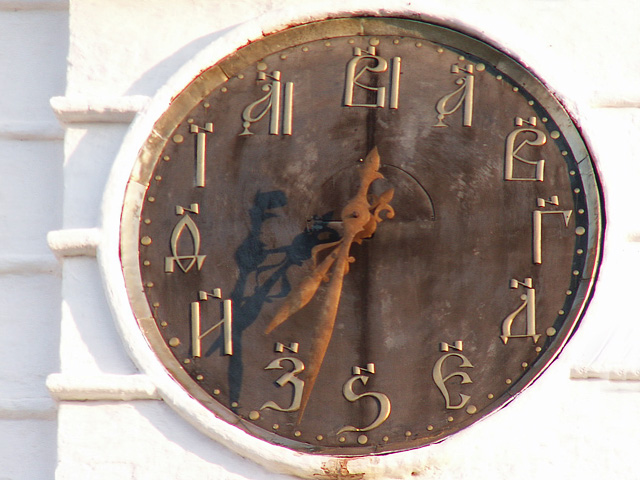Titlo on:
[Wikipedia]
[Google]
[Amazon]


 Titlo is an extended
Titlo is an extended
The Hirmos Ponomar font for viewing Church Slavonic texts
{{Navbox diacritical marks Cyrillic-script diacritics Church Slavonic language
diacritic
A diacritic (also diacritical mark, diacritical point, diacritical sign, or accent) is a glyph added to a letter or to a basic glyph. The term derives from the Ancient Greek (, "distinguishing"), from (, "to distinguish"). The word ''diacrit ...
symbol initially used in early Cyrillic and Glagolitic
The Glagolitic script ( , , ''glagolitsa'') is the oldest known Slavic alphabet. It is generally agreed that it was created in the 9th century for the purpose of translating liturgical texts into Old Church Slavonic by Saints Cyril and Methodi ...
manuscripts, e.g., in Old Church Slavonic
Old Church Slavonic or Old Slavonic ( ) is the first Slavic languages, Slavic literary language and the oldest extant written Slavonic language attested in literary sources. It belongs to the South Slavic languages, South Slavic subgroup of the ...
and Old East Slavic
Old East Slavic (traditionally also Old Russian) was a language (or a group of dialects) used by the East Slavs from the 7th or 8th century to the 13th or 14th century, until it diverged into the Russian language, Russian and Ruthenian language ...
languages. The word is a borrowing from the , and is a cognate of the words '' tittle'' and '' tilde''. The titlo still appears in inscriptions on modern icons and in service books printed in Church Slavonic.
The titlo is drawn as a line over a text. In some styles of writing the line is drawn with serifs, so that it may appear as a zigzag. The usual form in this case is short stroke up, falling slanted line, short stroke up; an alternative resembles a volta bracket: short stroke up, horizontal line, short stroke down.
The titlo has several meanings depending on the context:
A titlo is used as a scribal abbreviation mark for frequently written long words and also for nouns describing sacred persons. In place of , for example, 'God' was written under the titlo and ' espeaks' is abbreviated as . Fig. 3 shows a list of the most common of these abbreviations in current use in printed Church Slavonic. Fig. 2 shows 'Lord' abbreviated to its first letter and stem ending (also a single letter here, in the nominative case). Around the 15th century, titla in most schools came to be restricted to a special semiotic meaning, used exclusively to refer to sacred concepts, while the same words were otherwise spelled out without titla, and so, for example, while "God" in the sense of the one true God is abbreviated as above, "god" referring to "false" gods is spelled out; likewise, while the word for "angel" is generally abbreviated, "angels" is spelled out in "performed by evil angels" in Psalm 77. This corresponds to the Nomina sacra (Latin: "Sacred names") tradition of using contractions for certain frequently occurring names in Greek Scriptures.
A short titlo is placed over a single letter or over an entire abbreviation; a long titlo is placed over a whole word.
A further meaning was in its use in manuscripts, where the titlo was often used to mark the place where a scribe accidentally skipped the letter, if there was no space to draw the missed letter above.
Titlos are also used to mark letters when they are used as Cyrillic numerals, a quasi-decimal system analogous to Greek numerals
Greek numerals, also known as Ionic, Ionian, Milesian, or Alexandrian numerals, is a numeral system, system of writing numbers using the letters of the Greek alphabet. In modern Greece, they are still used for ordinal number (linguistics), ordi ...
.
Titlo is encoded in Unicode
Unicode or ''The Unicode Standard'' or TUS is a character encoding standard maintained by the Unicode Consortium designed to support the use of text in all of the world's writing systems that can be digitized. Version 16.0 defines 154,998 Char ...
as , and .
See also
*Pokrytie
Pokrytie ( ҇ ) is one of the historic diacritical signs of Cyrillic that was used in Old Church Slavonic, later medieval Cyrillic literary traditions and modern Church Slavonic.
It is a modification of titlo adapted for covering (hen ...
* Syriac Abbreviation Mark
References
External links
The Hirmos Ponomar font for viewing Church Slavonic texts
{{Navbox diacritical marks Cyrillic-script diacritics Church Slavonic language